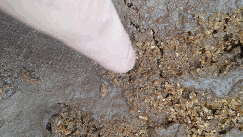GREAT JOB!!!
As you do more and more decoctions you will discover that the mud that forms can be steely grey to brownish tan color. When the mud is gray it is thick and slightly gummy. When it is tan, it is kind of powdery. When the mud is gray, sparging becomes a little bit more difficult. If a real thick layer forms, sometimes it has to be sliced in order for the sparge water to get through it. When the mud is tan and if sparge is ran too fast, the mud will be pulled through the bed and into the boiler. The mud should be light tan in color. Tan mud is less water repellant, than gray mud.
Gray mud is indication of a failure somewhere in the brewing process during one of the rest periods, or due to a lack of a rest period, improper rest temperature or a decoction step that might have been needed, due to the characteristics of the malt, was skipped. It usually has more to do from an improper rest temperature or from skipping a step.
Next time that you are going to brew using the decoction method, try this. Remove the first decoction from the main mash during the acid rest. That way, you will have a lot more time to work with the decoction, because enzymatic action taking place in the main mash while you are fiddling around with the decoction, will be nill. The decoction can be allowed to fully convert and can be boiled for a longer length of time. The longer a decoction is boiled, protein gum is boiled away and more amylopectin is released.
To ensure that lager will have the backbone to be aged properly, amylopectin helps out. The mouthfeel and body in beer comes from Limit Dextrins formed when amylopectin is reduced by beta and alpha and not so much from non-fermentable sugar created at higher mashing temps.
As you gain experience with the decoction method, you will notice that the decoction mash will darken two times during the decoction step. The first time it occurs is during conversion and the second time is when Malliard occurs. After Malliard occurs, mellanoidin forms.
A brewer that uses the decoction method, rather than the English method, has more opportunity to experience some of the pretty cool shizz that takes place during the boiling and mashing stages, that are part of the decoction method. A decoction brewer has more control over what ends up in the bottle.
 Your website was invaluable for working on my Dunkel and the enhanced double decoction that I used. Here's a GIF of the protein that was left sitting on top of my mash
Your website was invaluable for working on my Dunkel and the enhanced double decoction that I used. Here's a GIF of the protein that was left sitting on top of my mash 

 Your website was invaluable for working on my Dunkel and the enhanced double decoction that I used. Here's a GIF of the protein that was left sitting on top of my mash
Your website was invaluable for working on my Dunkel and the enhanced double decoction that I used. Here's a GIF of the protein that was left sitting on top of my mash 



